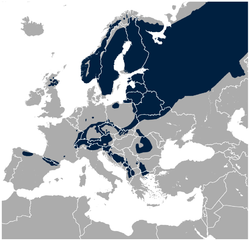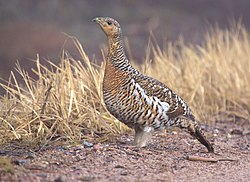The game birds and wild fowl of Sweden and Norway; with an account of the seals and salt-water fishes of those countries (1867) (14749362562)
Identifier: gamebirdswildfow00lloy (find matches)
Title: The game birds and wild fowl of Sweden and Norway; with an account of the seals and salt-water fishes of those countries ..
Year: 1867 (1860s)
Authors: Lloyd, L. (Llewelyn), 1792?-1876
Subjects: Game and game-birds Marine animals
Publisher: London, F. Warne and co.
Contributing Library: Smithsonian Libraries
Digitizing Sponsor: Smithsonian Libraries
View Book Page: Book Viewer
About This Book: Catalog Entry
View All Images: All Images From Book
Click here to view book online to see this illustration in context in a browseable online version of this book.
Text Appearing Before Image:
hyness, and fearlessly approaching people, has occasion-ally given rise in Sweden to the notion that it is actuallypossessed. About this time last year, Lieutenant Jack relates, whilst the cottager Anders Pehrsson, of Bengtsbo, inthe province of Wcstmanland, was collecting brushwoodin the forest, a Capercali cock, without showing thesmallest apprehension, came and alighted on the groundimmediately near him. The old l)elief in Troll-Foglar,or enchanted birds, once so common, and which is still ■■ May not the peojile-hating Capercali spoken of above be such ashave escaped from confinement) Or may tliey not have been .seized witha species of madness, as wonhl at times seem to be the case witli othei-birds? Tn Scandinavian Adventures, for instance, I have rekted tliaton one occasion a goshawk furiously attacked the horses harnessed to agentlemans carriage; and only recently we read in the English papers ofa poor girl being assailed and most cruelly maltreated about the face by arook !
Text Appearing After Image:
BEWITCHED BIRD. 17 retained by a portion of the peasanti-y, could not buthave its effect on the man from such clear and conclusiveevidence. With this crotchet in his head he thereforehastened to the klockare, or clerk of the parish, namedPettersson—who was also its oracle—residing at a distanceof about an English mile from the spot, and related tohim what had happened. Pettersson, who professed not to have the most distantapprehension of the troll and their emissaries, at onceput his gun ill order, and accompanied by Pehrssourepaired to the spot indicated, which the Capercali hadnot yet quitted. The klockare advanced to withina few paces of the bird and pulled the trigger, but thegun clicked. It-was cocked a second and a third time,though with the same result. The flint is now hammeredand fire at length produced, but confined to a flash in thepan. The ardour of the sportsman rose to the highestpitch. How provoking ! neither pricker nor other im-plement to clear the touchhole. Thes
Note About Images
Relevantní obrázky








and the IUCN Red List spatial data, CC BY-SA 4.0

and the IUCN Red List spatial data, CC BY-SA 4.0
















Relevantní články
Tetřev hlušecTetřev hlušec je velký druh hrabavého ptáka z čeledi bažantovití (Phasianidae), který je rozšířen v Eurasii od španělských Pyrenejí po východní Sibiř. Druh obývá starší jehličnaté a smíšené lesy různých nadmořských výšek. Vysokohorským podmínkám a tuhým zimám je přizpůsoben fyziologicky i ekologicky. Tetřev hlušec byl kdysi hojný i v Česku, nicméně úbytek vhodných stanovišť způsobil takřka úplné vymizení českých tetřevů a poslední životaschopná populace se nachází na Šumavě. Zbytkové populace se vyskytují i v českých příhraničních oblastech, jako je Český les nebo Beskydy. .. pokračovat ve čtení
